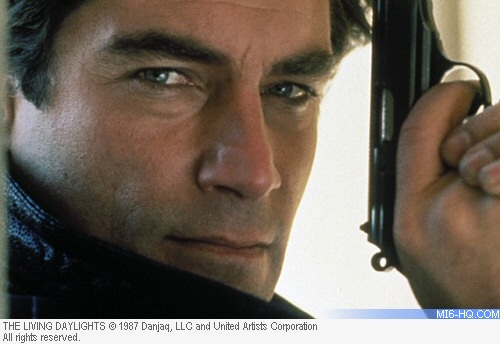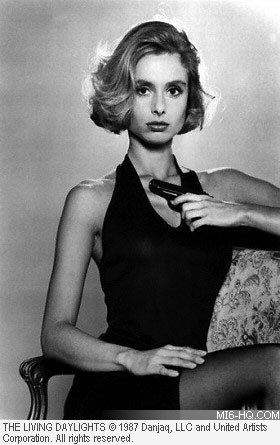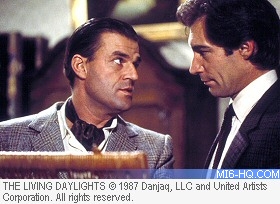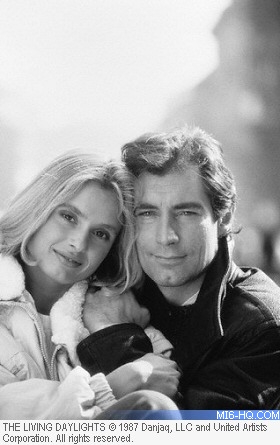Production Notes - The Living
Daylights
Following the disappointing performance of "A
View To A Kill" (1985),
and the departure of Roger Moore,
EON Productions decided that the
time had come for a reinvention of the Bond series. Veteran series
scriptwriter Richard Maibaum joined forces with executive producer
Michael G.
Wilson to create a screenplay exploring 007's very first
mission, detailing how he became the great agent that we had all
come to know and love. Albert
R. Broccoli could appreciate what
the men had done but was unhappy - he reasoned that no-one would
be interested in a younger Bond. What they wanted was what they
were used to, just bigger and better.

Above: Timothy Dalton as James
Bond.
|
So Maibaum and Wilson went back to their word
processors and built a whole new script around one of Ian
Fleming's
short stories,
The
Living Daylights which had appeared in the first issue of
The Sunday Times Magazine in February 1962. The story offered
little to go on, so the writers were forced to add a lot to Fleming's
meager narrative - the story forms the basis of the first 15
minutes
or so of the film before Maibaum and Wilson's own work takes
over. With the script beginning to take shape, Broccoli had to
begin again the arduous task of choosing a new big screen James
Bond.
|
Broccoli had initially settled on the
then 33-year-old Pierce
Brosnan, an Irish actor who he had first
met on the set of "For Your Eyes
Only" (1981) when he
joined his wife Cassandra
Harris [playing Countess Lisl]
and Broccoli
for lunch.
Broccoli had been suitably impressed by the actor and
had made a mental note even then to bear him in mind for
when the inevitable happened and Roger Moore finally jumped
ship. But in the intervening years, Brosnan and Harris
had relocated to Hollywood where Brosnan had landed the
title role in Mary Tyler Moore Television's hit comedy-drama
Remington Steele.
As luck would have it, NBC had just cancelled
Remington Steele as its audience figures began to decline
and Brosnan looked set to step into Moore's shoes. But as
word broke of Eon's interest in the young Irishman, NBC suddenly
decided to renew Remington Steele. Brosnan was still under
contract with Mary Tyler Moore Television and had no choice
but to press on with a final series of the show.
Brosnan
was devastated - he was losing the chance to play the biggest
role of his career. Little did he know then that the chance
would re-present itself less than a decade later and that
he would be instrumental in rejuvenating a series that
had looked as if it had finally died. |
|

Above:
007's newly found monogamy meant only one leading lady
in "The Living Daylights" - Maryam D'Abo played Kara Milovy.
|
Broccoli was forced to look harder for his new
Bond. Sam Neil was briefly considered as was the unknown Australian
actor Finlay
Light. But on 6 August 1986, EON announced that they had their
new Bond - welshman Timothy Dalton.
Dalton had a distinguished stage, television and screen
career
stretching back two decades. In 1968, he was considered the role
when Sean Connery left,
and could have made his debut appearance as
007 in "On Her Majesty's Secret Service"
(1969) had he not deemed himself too young for the role. Dalton
was approached by Broccoli again in 1982, when it looked like
Moore
was
going to resist playing Bond again in "Octopussy"
(1983). Dalton won the approval of Sean Connery, who wished him
well
and gave
his endorsement of the new Bond.
In keeping with the changing pace of public mores, the new Bond
was going to be less of a womaniser than he had been in the past.
That didn't, however, mean that there wouldn't be the obligatory
Bond girls, just that Bond would largely keep his hands to himself
this time round.
|
Lead Bond girl was Maryam
D'Abo, a former model who was
cast as the Czech cellist Kara Milovy. D'Abo had entered
Bond's sphere of influence in 1984 when she'd attended
auditions for the part of Pola Ivanova in "A View To a
Kill", a part that went eventually to Fiona
Fullerton. She got
the part in "The Living Daylights" after being employed
to help out in the auditioning of an as yet unidentified
actor
up for the part of Bond.
D'Abo had impressed Broccoli's
daughter Barbara, who was beginning to play an increasingly
important role in the Bond films, and it was she who
suggested that D'Abo audition for the part of Kara.
Chief villains Koskov and Brad Whitaker
were played by Dutch actor Jeroen
Krabbe and American Joe
Don Baker respectively.
Baker would return to the series after its rebirth in 1995
to play CIA agent Jack Wade in "Goldeneye" (1995)
and "Tomorrow Never Dies"
(1997).
Also in the cast was John
Terry making his only appearance
in the series as the sixth actor to play Felix Leiter in
the 'official' series [seventh if you count Bernie Kasey
in "Never Say Never Again"].
This was the first time the CIA agent had been seen in
the EON series since David
Hedison's
portrayal in "Live And Let Die" (1973).
|
|


Above
Top: Rogues gallery (left to right) - Andreas Wisniewski
as Nekros, Joe Don Baker as Brad Whitaker and Jeroen
Krabbe as
Koskov.
|
Desmond
Llewelyn, now the longest standing member of the semi-regular
cast [he'd been with the series since "From
Russia With Love"
(1963) and had missed only one film since, "Live and Let Die"]
was back, along with Robert Brown as
the new M. Caroline
Bliss, who had
played half of the title roles in the TV film "Charles and Diana:
A Royal Love Story" (1982), came on board as the new Moneypenny.
Production proper kicked off at Pinewood Studios on Monday 29
September 1986, the press still not having met the new Bond and
his leading lady. It wasn't until the main unit relocated to
Vienna,
again under the direction of John Glen, that a press conference
was staged. On Sunday 5 October, Dalton and D'Abo stepped into
the full glare of publicity as the world's press, eager for their
first glimpse of the new 007, descended on the city. At the conference,
he and Broccoli fended off accusations that the character had
become "paper thin" and asserted that the new Bond
was going to be tougher and psychologically deeper than before.
|
The production stayed in Vienna for two
weeks, shooting at the Cape Deme, the Reisenaad Big Wheel
in Prater Park
[that had last been used as a location in "The Third Man"
(1950)] and the Musikverein concert hall. Gibraltar
was the next port of call to shoot the teaser. Rock Gun
was
converted into a secret radar installation and the stunt
team saw their first real action, staging the spectacular
Land Rover leap from the cliff tops.
While on location in Gibraltar, the crew
got an unexpected photo opportunity. One of the officers
stationed on the
Rock was a captain in the Royal Artillery. His name? Bond
- James Bond. EON weren't going to pass up this unlikely
coincidence and put together a photo call which the world's
press was eager to attend, capturing shots of the real
and the fictitious James Bonds.
Back at Pinewood, shooting was halted for a few hours
on 11 December 1986 when the set was visited by the Prince
and Princess of Wales, fast becoming unofficial patrons
to the Bond series. The next morning, tabloids around the
world featured the now famous moment when the Princess
of Wales cracked a sugar-glass wine bottle over her husband's
head while visiting the props department. Filming
soon resumed and on 13 February 1987, filming was completed.
Broccoli barely had time to regain his breath before he collected
his honorary
OBE on 19 February.
|
|

Above: Dalton and D'Abo on location
in Vienna, unveiled to the world's media a few weeks in to
the film's production.
|
John Barry was
to bid farewell to the series with "The Living Daylights" and
he repeated the experiment he had tried on "A View
To a Kill", asking a pop band to help with the theme tune. This
time it was Norwegian trio A-Ha who apparently endured a rocky
relationship with Barry, the composer not seeing eye-to-eye with
the young upstarts. Barry later described the working relationship
as being like "playing ping pong with four balls." The
song may not have been as successful as Duran Duran's "A View
To
a Kill", but it still sold well enough to reach number five in
the British charts. Barry himself appeared in the film, if only
briefly, as a conductor.
The Prince and Princess of Wales attended the
film's premiere on 29 June 1987 at the usual venue, the Odeon
Leicester Square
in London. MGM/UA had ambitious plans for the film, striking
an unprecedented 250 prints for its nationwide release on 10
July.
In the States the film opened on the 31 July and didn't do as
well as EON or MGM/UA might have hoped - the downward slide
in
admissions that had marred the progress of the series through
the 80s continued, US cinemas admitting just 14.2 million punters,
the lowest number since "The Man With
the Golden Gun" (1974).
Worldwide gross was encouraging, but lower than was expected.
The grand
overhaul seemed to have failed.